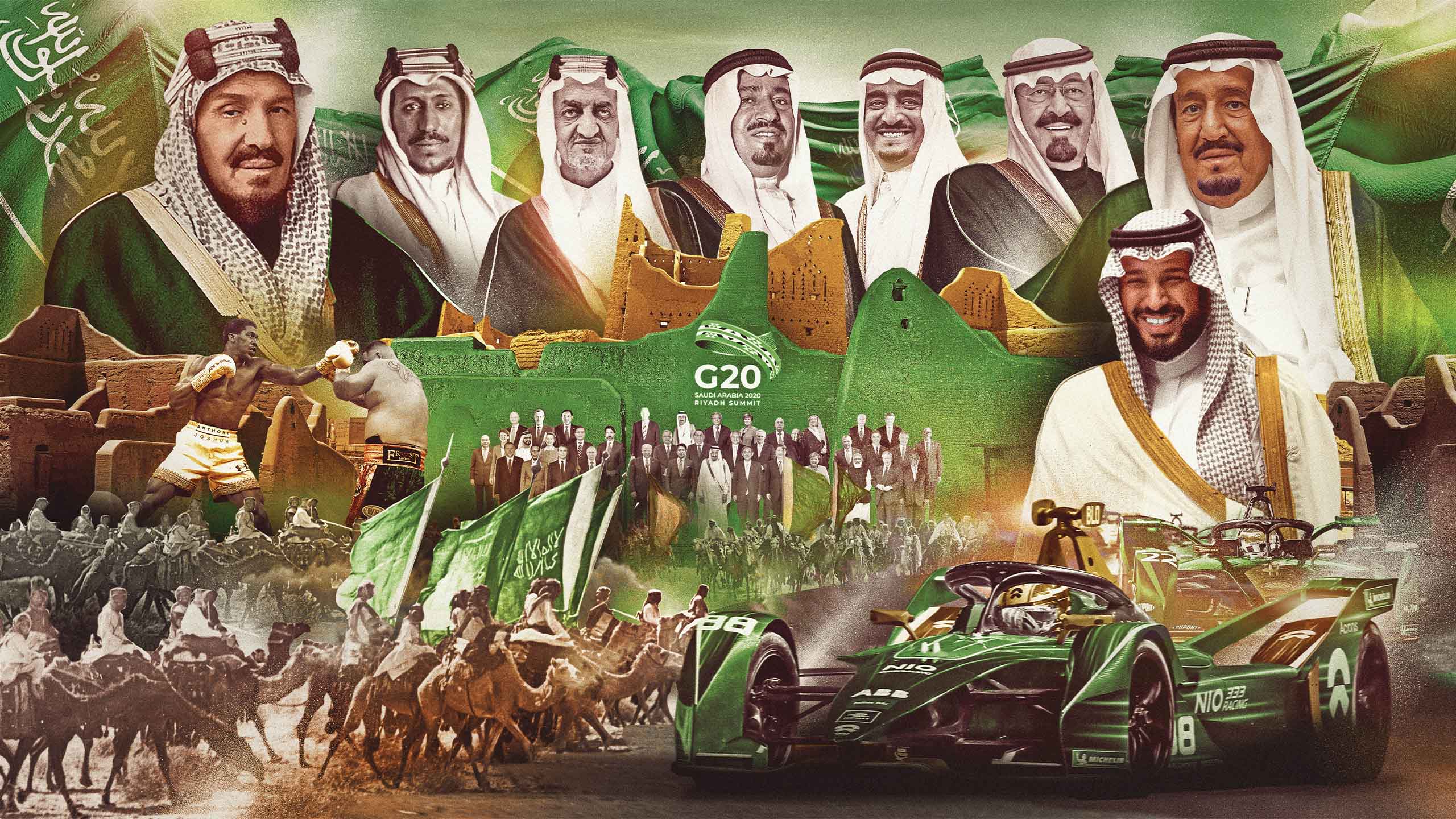Diriyah: past,
present and future
On Saudi Arabia’s 91st National Day, the birthplace
of the Kingdom continues to make history
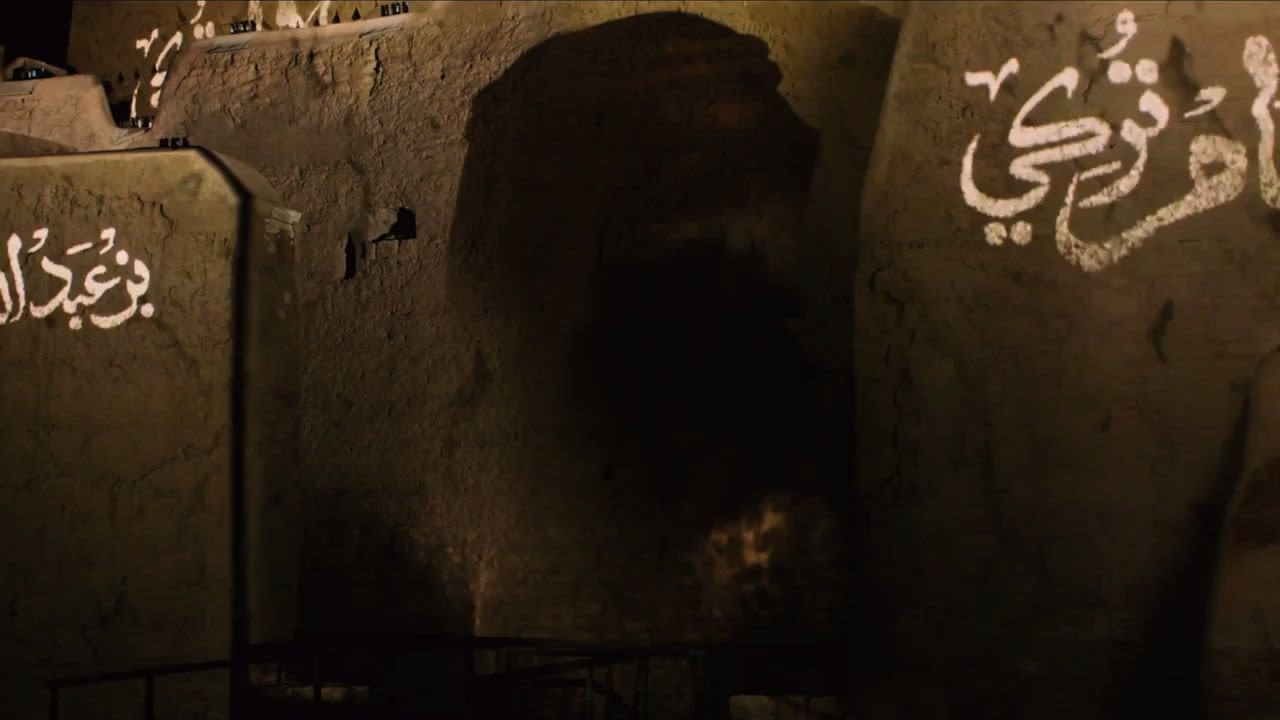
Just 10 kilometers west of Kingdom Tower in Saudi Arabia’s modern capital, Riyadh, lie the carefully restored remains of mud-brick structures that were once part of an imposing city.
This is At-Turaif, an archaeological treasure trove of royal palaces, mosques, homes and defensive towers built in the 18th century in the capital of the First Saudi State.
It was here, in what is now revered as the birthplace of the Kingdom, protected since 2010 as a UNESCO World Heritage Site, that the first chapters in the story of Saudi Arabia were written.
Now, as the jewel in the crown of Diriyah, one of Saudi Arabia’s largest gigaprojects, At-Turaif is also helping to write the next chapter of the Kingdom’s story.
Built by the forefathers of today’s Saudis in Diriyah, an oasis settlement founded in the 15th century along the Wadi Hanifah, At-Turaif is recognized internationally as an outstanding surviving example of the unique Najdi building style.
Built by the forefathers of modern-day Saudis in Diriyah, an oasis settlement founded in the 15th century along the Wadi Hanifah, At-Turaif is recognized internationally as an outstanding surviving example of the unique Najdi building style.
This distinctive architecture evolved over the centuries in central Arabia in response to the harsh conditions, making use of the few readily available natural materials: sun-fired adobe bricks, limestone quarried from the slopes of the wadi, and timber from the hardy tamarisk tree.
The remains of the mud-brick city offer mute testimony to the determination of a people not only to create a thriving, self-reliant society in one of the world’s harshest desert terrains, but also to do so in the face of seemingly overwhelming opposition from the Ottoman Empire.
Battered by shot and shell, the walls of At-Turaif bear the scars of a bloody siege in 1818 that lasted for six months before the defenders were finally overwhelmed. Many of their leaders were tortured, executed or exiled, and the city was abandoned.
That, however, was not to be the end of the story of At-Turaif, nor of Saudi Arabia.
Since the 1980s At-Turaif has been painstakingly restored. It now forms the heart of, and is the inspiration for, the Diriyah Gate development, an ambitious $50 billion plan to transform the neighboring historic town of Diriyah into a global historical, cultural and lifestyle destination that will add 27 billion Saudi Riyals to the Kingdom’s GDP, create 55,000 job opportunities and attract 27 million visitors every year.
Complete with museums, galleries, world-class hotels, restaurants, shops, homes and educational and cultural facilities, the 7 square kilometer development is being created in the traditional Najdi architectural style, while also taking advantage of the latest advances in sustainable urban living.
When Diriyah is complete, visitors from around the world will be able to immerse themselves in the history and culture of a kingdom that in less than 300 years has grown from an idea born in a small desert community to become one of the world’s most prosperous nations.
Past
Birthplace of a nation

Jerry Inzerillo, Group CEO Diriyah Gate Development Authority: "At-Turaif is to Saudi Arabia what the Acropolis is to the Greeks."
The cannonball was discovered by workers. They unearthed it during recent routine preservation work on one of the historic buildings in At-Turaif.
“We were doing repairs to a foundation,” said Adam Wilkinson, chief of heritage and culture at Diriyah Gate Development Authority. “One of the workmen came across this object and immediately called for our in-house archaeologist.”
The cannonball was found behind Salwa Palace, said Wilkinson, and “to have got there it must have been fired over, or through, quite a few buildings.”
"Greetings from the home of the heroic kings in Diriyah" - Dr. Badran Al-Honaihen, associate director of historical researches and studies at DGDA.
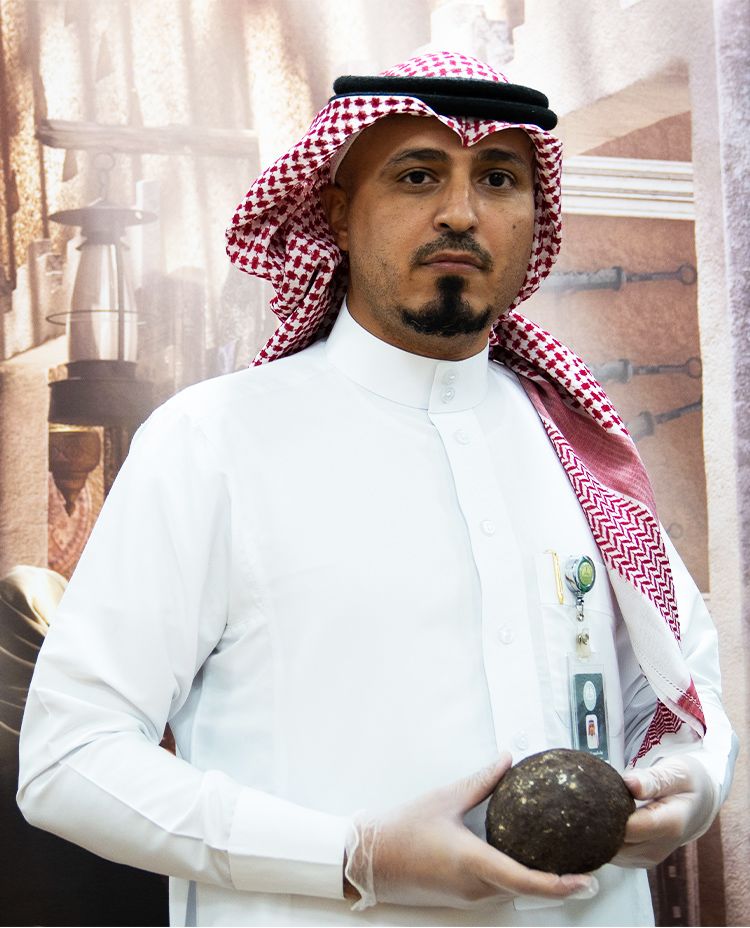
Nawaf Almeteri, an archaeologist with Diriyah Gate Development Authority, with the cannonball unearthed at At-Turaif.
A little over 200 years ago, that cannonball exploded from the mouth of a cannon fired by an Ottoman artilleryman, part of a vast army laying siege not only to At-Turaif, but to the very idea of an independent Arab state.
The 5,000-or-so defenders of At-Turaif were hopelessly outnumbered and outgunned by a force of 30,000 Ottomans, but held out for six months before finally succumbing to the inevitable.
Many of them, the flower of the youth of the First Saudi State, gave their lives during the heroic last stand. Others were driven into exile, or taken captive, tortured and executed on the orders of Ibrahim Pasha. The eldest son of Mohammed Ali Pasha, the Ottoman viceroy of Egypt and Sudan, he had led his father’s Turko-Egyptian forces in a bitterly fought six-year campaign against the Saudis.
Throughout the merciless war, Pasha’s army sent the severed heads or ears of their victims to Cairo in exchange for a bloody bounty.
In the end, the Ottomans did not overrun the defenders. Imam Abdullah, the last ruler of the First Saudi State, finally surrendered only when the prolonged suffering of his people became too much for him to bear.
Under heavy guard he was taken in chains first to Cairo and then to Constantinople, the seat of Ottoman power. There, he was publicly beheaded, his head crushed and his body strung up as a warning to anyone else who dared to challenge the authority of the empire.
The cannonball unearthed at At-Turaif serves as a stark reminder that the early chapters of the story of Saudi Arabia were written not in ink or in oil, but in the blood of heroes.
The pockmarked walls and shattered towers and palaces of At-Turaif, abandoned in 1818 but sensitively restored and preserved over the past 20 years, are monuments to the sacrifices of a generation of Saudis, and to the determination of a people to forge their own destiny.
Thanks to the work of Arab chroniclers, we know that this story began in 1446, when the first steps were taken on a long road toward the foundation of the Kingdom of Saudi Arabia, 486 years later.
According to Badran Al-Honaihen, associate director of historical researches and studies at Diriyah Gate Development Authority, the first steps toward that destiny, and ultimately toward the foundation of the Kingdom of Saudi Arabia, were taken in 1446 by Manaa' Al-Muraide, leader of the Marada clan of the Al-Duru tribe of Bani Hanifah and “the father of the Saudi royal family.”
The clan originated in central Arabia but generations before the time of Al-Muraide they had traveled east and established a settlement near Qatif on the shores of the Gulf. They named it Diriyah, after their tribal name, Al-Duru, and then carried that name back with them when they returned to their Arabian heartland in the 15th century.
They migrated in response to an invitation from Al-Muraide’s cousin, Ibn Dir. The ruler of Hajr, a town on the site of modern-day Riyadh in Al-Yamamah, an area of ancient settlements in the lower Najd along Wadi Hanifah, he was keen for unused, fertile land he owned to be settled by a friendly people and put to productive use.
He suggested to Al-Muraide that his clan should return from the coast and settle there, and “the invitation was well received,” said Al-Honaihen. “In 1446, Al-Muraide and his clan began their migration from the eastern city of old Diriyah to the center of the peninsula, where they established the new Diriyah.”
The 400-kilometer journey was not an easy one but eventually the caravan arrived at Wadi Hanifah.
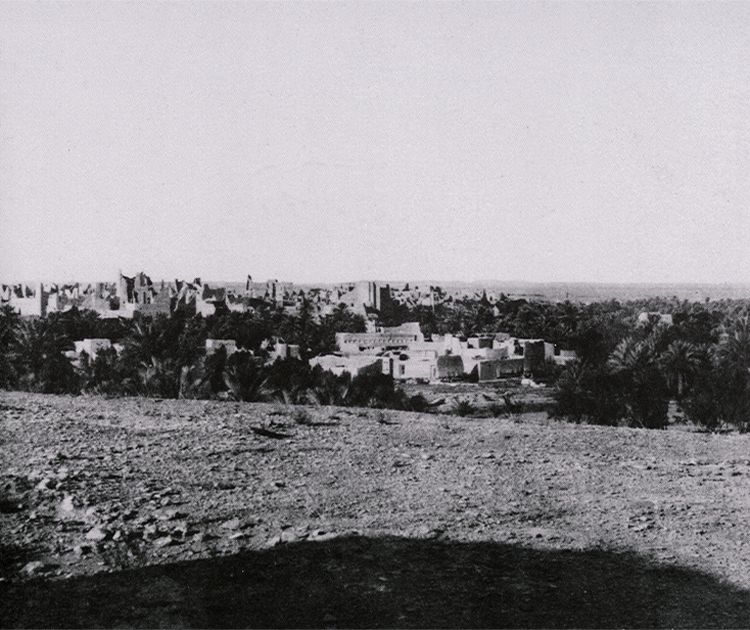
Early in the 20th century Diriyah was visited by the British officer Gerard Leachman, who in 1912 took the first known photograph of Diriyah.
Early in the 20th century Diriyah was visited by the British officer Gerard Leachman, who in 1912 took the first known photograph of Diriyah.
“Ibn Dir welcomed them and he and Al-Muraide agreed to restore the glory of their ancestors, who had once settled in the region and secured trading and pilgrimage routes,” said Al-Honaihen.
The clan transformed the land into a productive oasis, nourished by the fertile soil of Wadi Hanifah and well positioned at the crossroads of trading routes. But none could have foreseen the great destiny that lay in store for the settlement; indeed, 300 years would pass before the path began to become clear.
Nevertheless, said Al-Honaihen, “these events were among the most prominent to take place in the Arabian Peninsula” at the time. Al-Muraide’s arrival “laid the building blocks for the establishment of the greatest state in the history of the Arabian Peninsula, after the Prophetic State and the Rashidun Caliphate.”
"Welcome to At-Turaif" – Saudi tour guide Rahaf Al-Harbi on the 300 years of history that underpins Diriyah.
For many years the Al-Muqrin and Al-Watban branches of the clan vied for control of the settlement, but in about 1720 Saud ibn Mohammed of Al-Muqrin assumed the leadership. With this momentous transfer of power, the House of Saud was founded.
Historians date the origin of the First Saudi State to 1727, when Saud’s son, Mohammed, became the ruler of the town. Imam Mohammed ibn Saud, said Al-Honaihen, was the great-great-great-great-grandfather of King Salman and “one of the most important figures” in the story of Saudi Arabia.
After he became emir, Mohammed “focused his efforts on stabilizing the region and securing routes for commerce and pilgrimage,” Al-Honaihen explained.
“Under his rule, the emirate of Diriyah became one of the strongest independent emirates in Najd and was free of the dominance of regional powers.”
After Imam Mohammed’s death in 1765, his successor, Imam Abdulaziz, built on the unity he had created. During his reign, in about 1766, the royal district of At-Turaif was founded and work began on Salwa Palace, one of the most spectacular buildings that can still be seen at the UNESCO World Heritage site.
In 1803, Abdulaziz was succeeded by his son, Saud. He became known as Saud the Great “due to the greatness the Saudi state achieved under his reign, stretching from the edges of the Euphrates and the Levant in the north to Sanaa and Masqat in the south, and from the coast of the Arabian Gulf in the east to the Red Sea in the west,” said Al-Honaihen.
“During Imam Saud’s rule, the state was rich, proud and powerful,” covering an area larger than modern-day Saudi Arabia.
But within its incredible success, and the growing threat it therefore posed to the authority of the Ottoman Empire, grew the seeds of its downfall.
In 1804, Madinah and the Red Sea port of Yanbu were absorbed into the Saudi state. By 1807 Imam Saud had driven out the last Ottoman forces from Makkah. In doing so he laid claim to the rightful guardianship of the Two Holy Cities that had underpinned Constantinople’s status as the caliphate of Islam, a title it had claimed by force since the early 16th century.
In 1811, Ottoman forces under the command of Ibrahim Pasha landed at Yanbu on Arabia’s Red Sea coast. It was the start of a bloody, six-year campaign that would end with the defeat of Diriyah and the abandonment of At-Turaif.
After the death of Imam Saud in 1814, the throne passed to his son, Abdullah. He was destined to be the last ruler of the First Saudi State – the clock was ticking for him and for it.
In a series of valiantly fought but ultimately one-sided battles, the Saudis were slowly but surely driven back until, by March 1818, they had their backs to the walls of Diriyah.
What happened during the six months that followed is perhaps the darkest, but certainly one of the most heroic, chapters in the story of Saudi Arabia.
At-Turaif is now recognized by UNESCO as being of “outstanding universal value.” But it is especially precious to the Saudi people, not only as the birthplace of the Kingdom of Saudi Arabia, but also as a symbol of the rise and ultimate triumph of the House of Saud against seemingly insurmountable odds.
At Diriyah in 1818, the defenders were outnumbered six to one. Pasha might have expected a swift surrender, but there would be no such thing. Instead, in a heroic last stand, Imam Abdullah and his people held out for six long months.
Hundreds sold their lives dearly. By some estimates, for each one of the 1,200 defenders who fell, 10 of Pasha’s men breathed their last in the shadow of the walls of Diriyah.
When the siege was finally over, the Ottomans withdrew from Najd, but not before laying waste to Diriyah, destroying buildings and fortifications. They also cut down every date palm, undoing years of patient cultivation and condemning people across a wide area to starvation.
The battered At-Turaif district, the scene of some of the heaviest fighting, would never be fully occupied again. Within months of the enemy’s withdrawal, some determined Saudi survivors had begun to rebuild parts of Diriyah, but in 1821 the town was attacked for a second and final time.
The battered At-Turaif district, the scene of some of the heaviest fighting, would never be fully occupied again.
It was the end of Diriyah as the Saudi capital but, undeterred, the Saudis rose yet again, this time under the leadership of Imam Turki bin Abdullah Al-Saud. In 1824 he finally drove out the Ottomans for good. With Diriyah and At-Turaif in ruins, he chose the nearby, intact garrison town of Riyadh as the capital of the Second Saudi State.
The battle for nationhood was still far from over. In 1834, Imam Turki was assassinated and several years of civil war followed. They ended only when his son, Faisal, became the Imam and embarked afresh on rebuilding the Second Saudi State. The Ottomans came to Riyadh again and took Imam Faisal to Egypt, but in 1843 he returned from captivity and continued with the task of rebuilding the state.
Following his death in 1865, however, the state was once again riven by in-fighting until, in 1891, Saudi rival Ibn Rasheed occupied Riyadh. With the end of the Second Saudi State, the surviving Al-Sauds and their followers sought refuge in Kuwait.
It was then, even as Saudi fortunes seemed to be at their lowest ebb, that a hero emerged. Among those who traveled to Kuwait was 16-year-old Abdulaziz ibn Abdul Rahman Al-Saud. The son of the exiled last Imam of the Second Saudi State, he was destined to become better known to the wider world as Ibn Saud, founder of the Kingdom of Saudi Arabia.
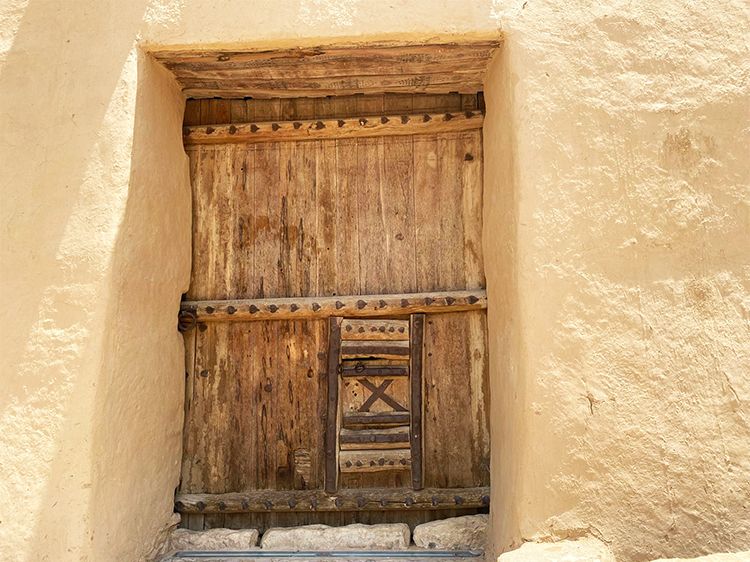
The door to Masmak Fortress in Riyadh, through which King Abdulaziz and his men fought their way in 1902.
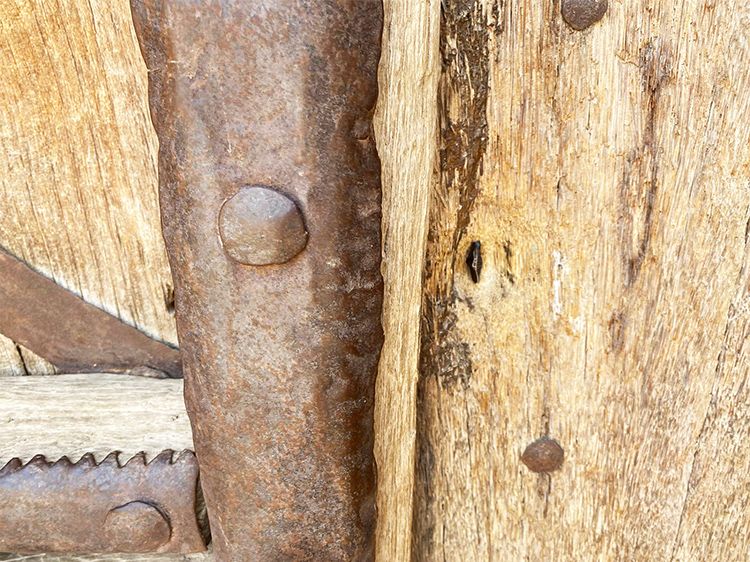
The tip of a spear thrown by one of King Abdulaziz's warriors during the recapture of Riyadh in 1902 can still be seen embedded in the door of the fortress, just to the right of the large bolthead in this photograph.
The story of how Prince Abdulaziz led a small band of warriors to recapture Riyadh in 1902 by storming the fortress of Masmak, 20 kilometers southeast of At-Turaif, and restored the House of Saud to its rightful place, is etched in the hearts of all Saudis.
The renown of the mission, and the man who pulled it off, spread to the wider world thanks to a dispatch sent to the Foreign Office in London in 1917 by Gertrude Bell, the intrepid British political officer stationed in Iraq during the First World War.
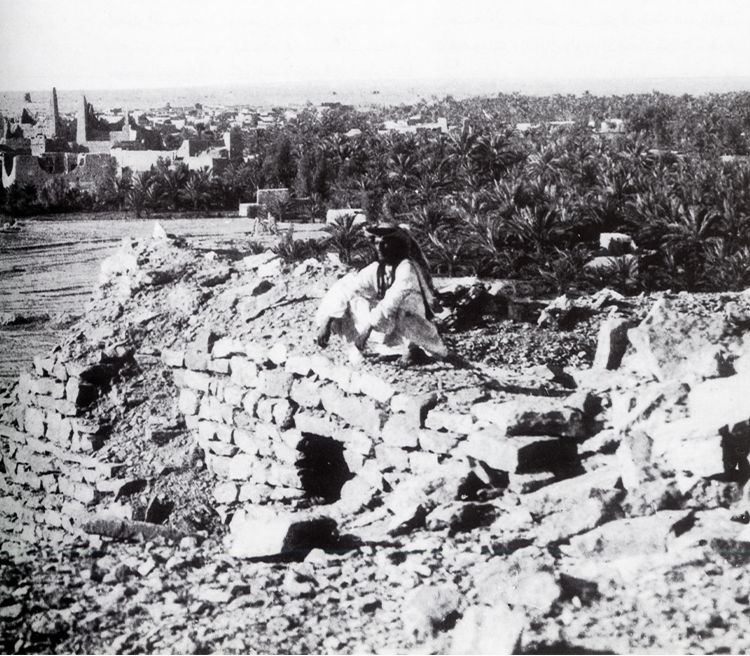
A photograph of the ruins of At-Turaif taken in 1917 by British explorer Harry St John Bridger Philby, who settled in Jeddah and became an advisor to Ibn Saud. (Diriyah Gate Development Authority)
A photograph of the ruins of At-Turaif taken in 1917 by British explorer Harry St John Bridger Philby, who settled in Jeddah and became an advisor to Ibn Saud. (Diriyah Gate Development Authority)
Bell, a fluent Arabic speaker, met Abdulaziz in Basra in November 1916. She described him as “a man of splendid physique, standing well over six feet and carrying himself with the air of one accustomed to command.” He was possessed of “dignity and charm” and “powers of physical endurance rare even in hard-bitten Arabia.”
She added: “As a leader of irregular forces he is of proved daring, and he combines with his qualities as a soldier that grasp of statecraft which is yet more highly prized by the tribesmen.”
Those qualities would serve Abdulaziz well, because his recapture of Riyadh was just the beginning. In the years that followed, he and the tribes that flocked to his banner repelled a series of attacks on his territory, first by Ottoman forces and then by the Hashemites of the Hijaz.
Gradually, though, he expanded the territory under his control until, in 1924, his forces seized Makkah, restoring it to the Saudi state.
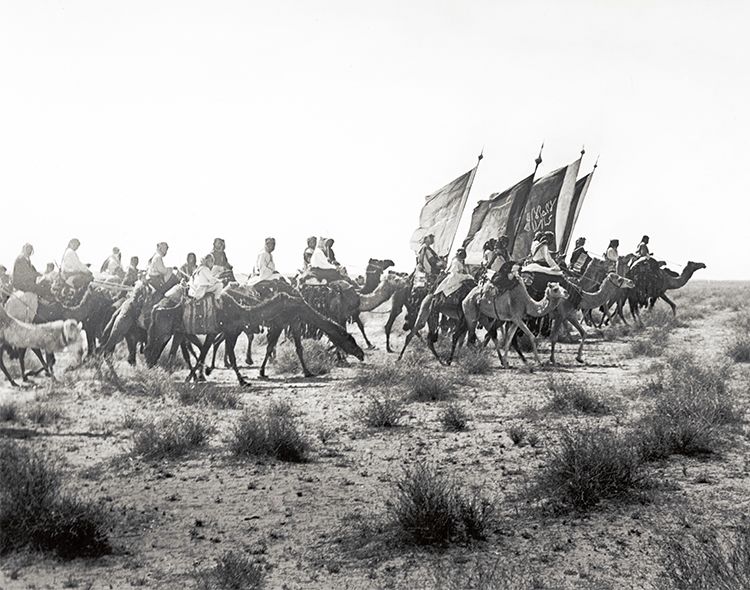
A rare photograph of the army of Abdulaziz on the march, photographed by British envoy Captain Shakespear near Thaj in March 1911. (Getty Images)
A rare photograph of the army of Abdulaziz on the march, photographed by British envoy Captain Shakespear near Thaj in March 1911. (Getty Images)
Abdulaziz united the kingdoms of Najd and Hejaz and, on Sept. 23, 1932, proclaimed the foundation of the modern Kingdom of Saudi Arabia.
As the capital of the new Saudi state, Riyadh thrived — and during the 1970s its predecessor, Diriyah, would rise again, this time as a new town on the outskirts of the rapidly expanding capital.
As for At-Turaif, more than 150 years after the fall of the First Saudi State it was to be one of the sons of King Abdulaziz who would rouse the nation to recognition of the historical importance of an area abandoned in 1818, and its significance to the story of Saudi Arabia.

Nawaf Almeteri, an archaeologist with Diriyah Gate Development Authority, with the cannonball unearthed at At-Turaif.
Nawaf Almeteri, an archaeologist with Diriyah Gate Development Authority, with the cannonball unearthed at At-Turaif.

The door to Masmak Fortress in Riyadh, through which King Abdulaziz and his men fought their way in 1902.
The door to Masmak Fortress in Riyadh, through which King Abdulaziz and his men fought their way in 1902.

The tip of a spear thrown by one of King Abdulaziz's warriors during the recapture of Riyadh in 1902 can still be seen embedded in the door of the fortress, just to the right of the large bolthead in this photograph.
The tip of a spear thrown by one of King Abdulaziz's warriors during the recapture of Riyadh in 1902 can still be seen embedded in the door of the fortress, just to the right of the large bolthead in this photograph.
Present
A labor of love and honor

By definition, a brick made of mud is a humble object, forged from the most basic of components: earth, water and hay, pressed into shape and then baked in the heat of the Arabian desert sun.
There was, however, nothing remotely humble about the mud-brick structures built in At-Turaif, on a limestone plateau overlooking Wadi Hanifah, by the craftsmen of the Najd. More than two centuries later, they form the historic heart of the sympathetic Diriyah Gate development that is taking shape there.
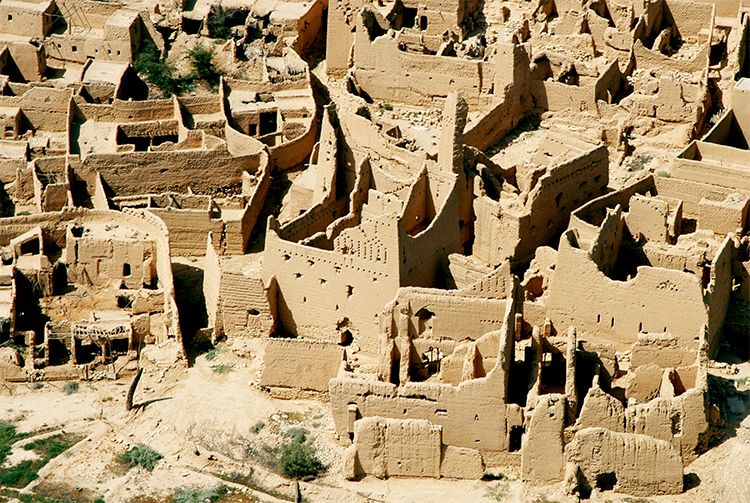
At-Turaif, an astonishing city of imposing palaces, created from the simplest of materials – mud.
At-Turaif, an astonishing city of imposing palaces, created from the simplest of materials – mud.
The Najdi builders created imposing palaces not only fit for the rulers of the First Saudi State, but also capable of enduring everything that war and weather could throw at them for 200 years.
In this city that was “the home of the heroic kings in Diriyah, the historical and cultural capital of the first Saudi state,” said Al-Honaihen, “the unity, security and public safety of the Arabian Peninsula originated, from the Arabian Gulf to the Red Sea, and from the edges of the Levant and Iraq to the edges of Yemen and Oman.”
At-Turaif contains the remains of numerous palaces and other buildings, the earliest of which is Salwa Palace, which was built in a strategic location in the middle of the district overlooking Wadi Hanifah.
"An ambassador of your country" – tour guides at Diriyah explain why they are so passionate about their work.
“Among the prominent people who resided in it were the second Imam, Abdulaziz ibn Mohammed, the founder of At-Turaif district, in addition to Imam Saud the Great, and Imam Abdullah ibn Saud,” said Al-Honaihen.
“It is ‘the crown jewel’, if you will. The highest point of Salwa Palace exceeds 20 meters, which is a great height. What is amazing is that it is a palace made of mud that has been there for 250 years.”
Wilkinson, the Diriyah Gate Development Authority’s heritage and culture chief, said At-Turaif owes its survival to one key factor: “the quality of the original building work. We have mud-brick walls here that are up to three meters thick, and the mud brick itself is of very high quality, made using a particular technique that made it very, very strong — so strong that it could resist many of the cannonballs fired during the siege of 1818. The survival of At-Turaif is a testimony to those original builders.”
Fortunately for the future of this priceless gift from the nation’s past, the unique Najdi architecture attracted the interest of one man in particular who was in a position to do something about preserving it.
During his almost 50-year tenure as governor of Riyadh, Prince Salman ibn Abdulaziz Al-Saud, now King Salman, spearheaded the restoration of At-Turaif and the rehabilitation of Wadi Hanifah.
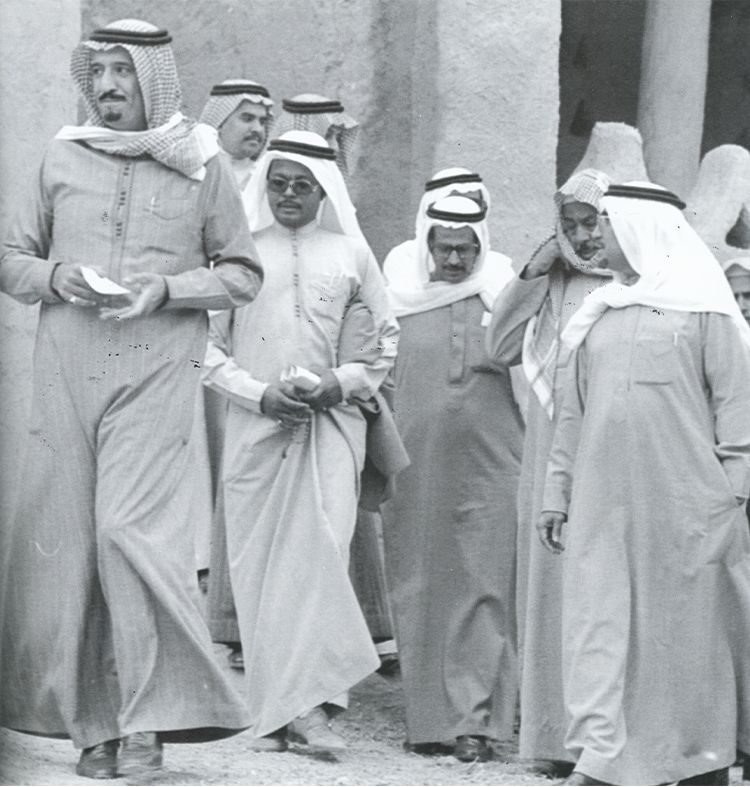
King Salman on an inspection tour of the buildings of At-Turaif while he was governor of Riyadh.
King Salman on an inspection tour of the buildings of At-Turaif while he was governor of Riyadh.
A 10-year restoration of the long-neglected buildings at At-Turaif began in earnest with the launch of the Historic Diriyah Development Program in 1998, under the auspices of the Royal Commission for Riyadh City, in conjunction with the Saudi Commission for Tourism and National Heritage, and Diriyah Governorate.

Many of the palaces of At-Turaif were badly damaged during the siege of 1818.
Many of the palaces of At-Turaif were badly damaged during the siege of 1818.
With that work all but complete, in 2010 At-Turaif earned recognition as a UNESCO World Heritage site of “outstanding universal value.” In 2017 it was handed over to the newly formed Diriyah Gate Development Authority.
Following the listing in 2008 of the archaeological site of Hegra, the ancient rock-carved city of the Nabataean civilization in the northwest of the Kingdom, At-Turaif was the second place in the country to be inscribed by UNESCO. In the 11 years since, another four Saudi sites have earned a place on the list: Historic Jeddah, the rock art in Hail, Al-Ahsa Oasis, and the Hima Cultural Area.
Although these six sites together span 10,000 years of history, it is perhaps At-Turaif, as the birthplace of the First Saudi State, that best captures the essence of the story of the creation of the modern Kingdom of Saudi Arabia.
A sense of the importance of the site, and the scale of the task faced by those who set out to restore and preserve it, was conveyed in a passage from the book “The Kingdom,” written 40 years ago by British author Robert Lacey, who spent four years living in Saudi Arabia.
“The shattered walls and gutted homes of the original Saudi capital,” he wrote in 1981, after visiting the site in the late 1970s, remained almost as they had been when abandoned a century and a half before.
“There are mosques, shops, watchtowers, homes, the busy structure of an entire metropolis, all open to the sky and eerily vacated like a sand-blown Pompeii.”
After the events of 1818, Lacey added, the House of Saud never attempted to rebuild Diriyah but “left the shell of their old capital behind them, an enduring reminder of the frontiers of the possible.”
UNESCO, of course, deals less in the emotional importance of historic places than in the elements that speak to the tangible value of heritage.
Accordingly, the nomination document that secured At-Turaif’s place in the pantheon of universally significant cultural sites describes “an outstanding example of earthen architecture particularly remarkable for the quality of its mud-brick masonry laid on limestone foundation … a traditional human settlement in a desert environment reflecting the intimate link between landscape, natural resources and the human efforts to settle the land.”
The combination of building materials and construction techniques, it adds, reflects “the unique development of the traditional know-how of At-Turaif master builders.”
The 18th-century palaces of the House of Saud “are particularly remarkable for the quality of their mud-brick masonry, and the vestiges of the palaces preserve a complete catalog of the stylistic characteristics of Najd architecture,” which “contribute to the world’s cultural diversity.”
Over the years of restoration projects, the skill and know-how of the Najdi master builders who created At-Turaif has been studied and reacquired by a new generation of craftsmen.
Over the years of restoration projects, the skill and know-how of the Najdi master builders who created At-Turaif has been studied and reacquired by a new generation of craftsmen.
“The mud-brick buildings of At-Turaif have been there for more than 250 years and have survived erosion, brutal invasion by the Ottoman empire and many other problems,” said Al-Honaihen.
This, he added, is an object lesson in sustainability that relies on materials taken from the local environment, learnt by the craftsmen being trained “to work with mud bricks and focus on sustainability, whether by using the stones and soil from the wadi or by using the local plants and trees that were used to create such tall buildings as Salwa palace.”
Reem Alkhaldi, an architect and senior design manager at the Diriyah Gate Development Authority, said the opportunity not only to work on At-Turaif but also to showcase the site for a new generation to appreciate and understand, is a dream come true.
“Before the Diriyah Gate Development Authority was established, my master’s thesis was about At-Turaif and how to allow people back into it to understand more about our history,” she said. In 2018, after the site had been placed in the care of the authority, “we were asked to introduce it to the public,” she added.
The staging of the inaugural Diriyah ePrix, a Formula-E championship race for electrically powered racing cars, in December that year, and the expected influx of thousands of fans from Saudi Arabia and other countries, was seen as the perfect opportunity to experiment with ways of doing that.

When At-Turaif was opened to visitors during the Formula E races in 2018, actors brought some of the restored buildings to life. (DGDA)
When At-Turaif was opened to visitors during the Formula E races in 2018, actors brought some of the restored buildings to life. (DGDA)
“It was a big challenge,” Alkhaldi said. In addition to training large numbers of guides to staff the four museums on the site, “we also decided to create an experience that simulated how the buildings in At-Turaif used to function and how people used to live in the First Saudi State.”
Among the properties that had been handed over to the development authority were 13 mud houses that had been restored on the outside but were empty shells inside.
“So we thought, why not bring this neighborhood back to life as it was 300 years ago and create a living experience — a living museum?” said Alkhaldi.

In 2018 At-Turaif became a living museum, in which visitors were able to experience life in Diriyah at the time of the First Saudi State. (DGDA)
In 2018 At-Turaif became a living museum, in which visitors were able to experience life in Diriyah at the time of the First Saudi State. (DGDA)
The houses were stocked with period clothes, food and furniture, and actors were hired and trained to portray typical residents of the era. Each building focused on a different aspect of the area’s history. It proved to be a moving experience for all who visited.
“Before, I never realized that architecture could actually have a voice,” said Alkhaldi, who graduated with a degree in architecture from Prince Sultan University in Riyadh, and a master’s degree in the preservation and alteration of historic buildings from the University of the Arts London.
“But I met a lot of people who had just had their first tour of At-Turaif and the level of pride and understanding about their country was obvious; you could see it in their eyes, and the realization that our history does not start only with today’s state but goes back hundreds of years.”
Many visitors, she added, were also surprised to learn that buildings as imposing and impressive as the palaces of At-Turaif were made from mud.
In fact, said Njoud Alanbari, a conservation architect with the Diriyah Gate Development Authority, “from a building point of view, mud is the most flexible and organic material to work with. So in conservation terms, whereas materials such as stone and marble are far more sensitive to work with, mud is far easier.
“I see it like your skin: when you scratch yourself your body heals itself, and mud is much the same when it comes to repairs.”
Yet although they are relatively simple and durable to work with, mud bricks and the science behind them are actually surprisingly sophisticated, she added, and the production of the bricks is a lengthy process that can take a month or more.
The ratios of the mix of materials in the brick — clay, sand, gravel, hay and water — are very important. This is something the builders of old knew instinctively. Their modern counterparts have perfected the techniques through experimentation, creating bricks that meet carefully measured standards of weight and strength.
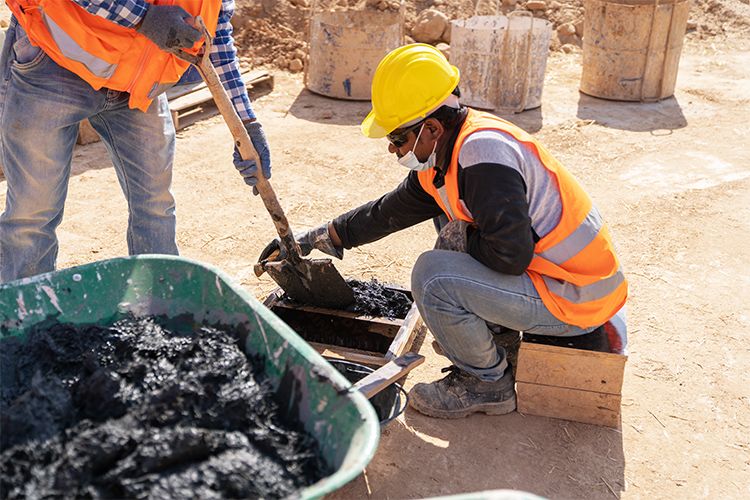
Making mud bricks begins with excavating clay and mixing it with sand, straw and water. (DGDA)
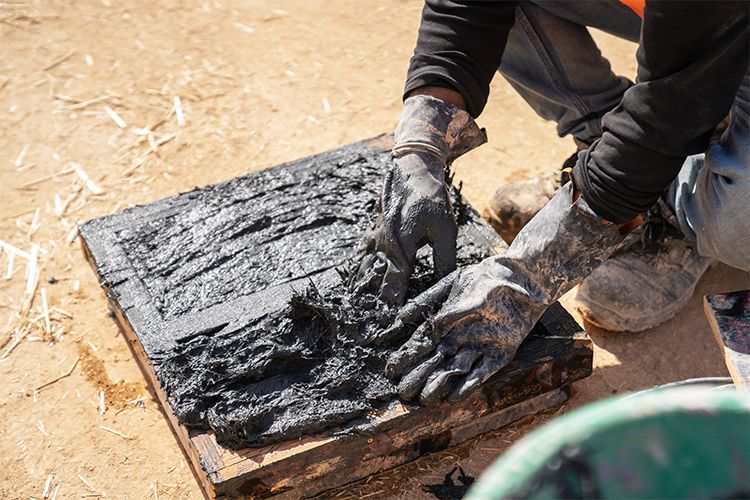
The mixture is left to ferment for at least 30 days, after which it can be used as plaster or mortar or shaped into bricks in wooden moulds. (DGDA)
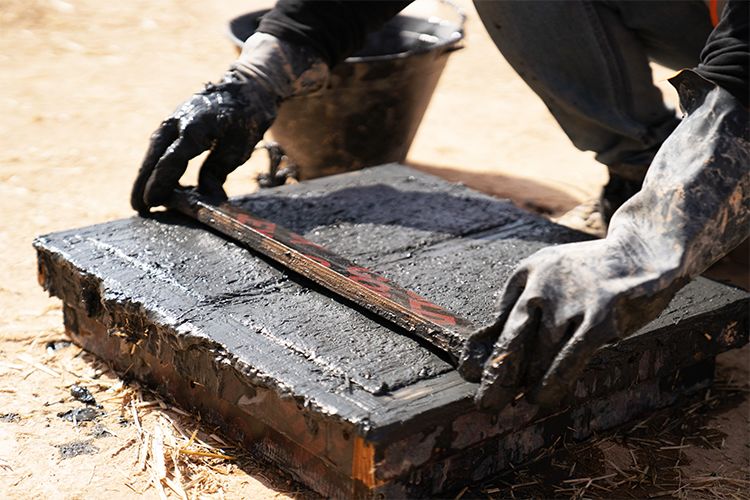
The shaped bricks are left outside in their moulds to bake in the heat of the sun for up to three weeks. (DGDA)
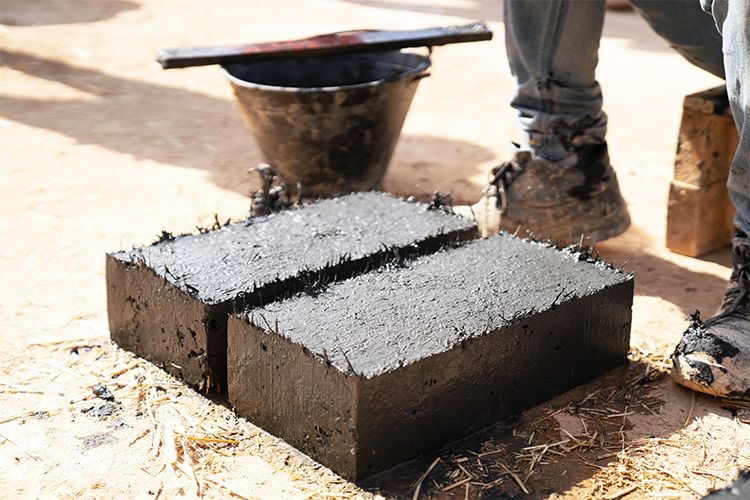
The finished product. Tough enough to endure the ravages of war and centuries of neglect and erosion. (DGDA)
Alanbari and her department are developing construction standards to help train the craftsmen and mud architects of the future, and to inform the work of a planned institute that will provide advice and guidance for other mud-brick projects in the Kingdom and other countries.
The most immediate and important project, however, remains the 7 square kilometer development of Diriyah where, thanks to a royal edict, the ancient art of making mud bricks has been granted a new lease of life on the grandest of scales.
The ancient art of mudbrick-making has been granted a new lease of life on the grandest of scales.
“I was really happy because Crown Prince Mohammed bin Salman said that all of the mud bricks that would be used in Diriyah should be authentic, traditional-style mud bricks,” said Alanbari.
Although modern machinery is being used to produce the vast quantities of the mud-and-hay mix required, replacing the human hands and feet used in the original manual production process, the craftsmen trained by the development authority are creating and working with millions of the very same type of bricks used to build At-Turaif almost 300 years ago.
As a result, Diriyah is a stunning, living architectural tribute to the achievements and legacy of the First Saudi State.
Tough, demonstrably resilient and representing the very definition of sustainability, the humble mud brick, far from being a redundant technology, is enjoying a renaissance as both the inspiration and the raw material for one of the most ambitious gigaprojects to date in Saudi Arabia.
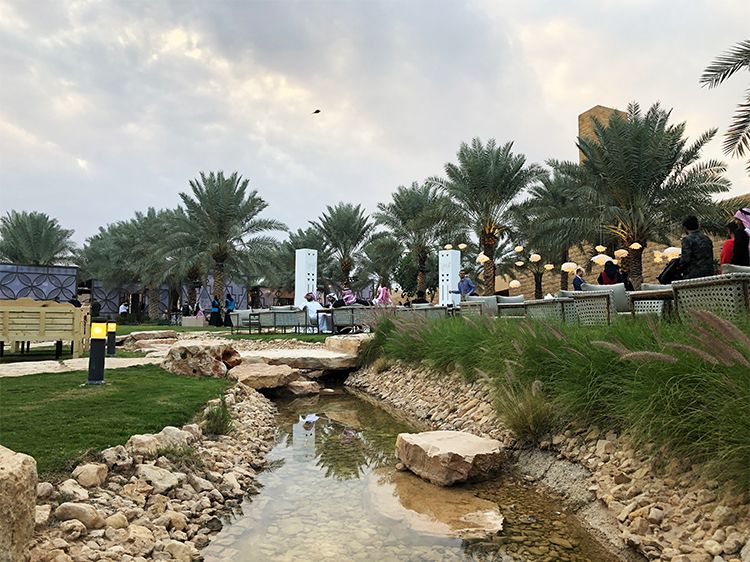
Diriyah is one the oldest districts of the Saudi capital, Riyadh. (Shutterstock)
Diriyah is one the oldest districts of the Saudi capital, Riyadh. (Shutterstock)

Making mud bricks begins with excavating clay and mixing it with sand, straw and water. (DGDA)
Making mud bricks begins with excavating clay and mixing it with sand, straw and water. (DGDA)

The mixture is left to ferment for at least 30 days, after which it can be used as plaster or mortar or shaped into bricks in wooden moulds. (DGDA)
The mixture is left to ferment for at least 30 days, after which it can be used as plaster or mortar or shaped into bricks in wooden moulds. (DGDA)

The shaped bricks are left outside in their moulds to bake in the heat of the sun for up to three weeks. (DGDA)
The shaped bricks are left outside in their moulds to bake in the heat of the sun for up to three weeks. (DGDA)

The finished product. Tough enough to endure the ravages of war and centuries of neglect and erosion. (DGDA)
The finished product. Tough enough to endure the ravages of war and centuries of neglect and erosion. (DGDA)
Future
A world class destination

Jerry Inzerillo, Group CEO, Diriyah Gate Development Authority: "Early in the new year of 2022, we will deliver our first assets.
“Diriyah will be one of the most amazing cultural gathering places in the world,” said Talal Kensara.
This is an ambitious promise. But as head of strategy management, responsible for ensuring that all the objectives of the Diriyah Gate Development Authority are met according to plan, it is one he can make with a great deal of authority and confidence.
Diriyah is within an eight-hour flight of about 80 percent of the world’s population and, when complete, it will offer a great deal to tempt the estimated 27 million visitors expected each year.
On one level, the development will have everything one might expect from one of the flagship gigaprojects being developed by Saudi Arabia in accordance with the nation’s Vision 2030 master plan to diversify and grow its economy and open up the Kingdom to the world.
So, yes, Diriyah will feature a dazzling array of restaurants, shops, five public plazas, luxury hotels and homes, multiple recreational spaces, museums, galleries and offices. It will be a thriving community, well worth a visit in its own right.
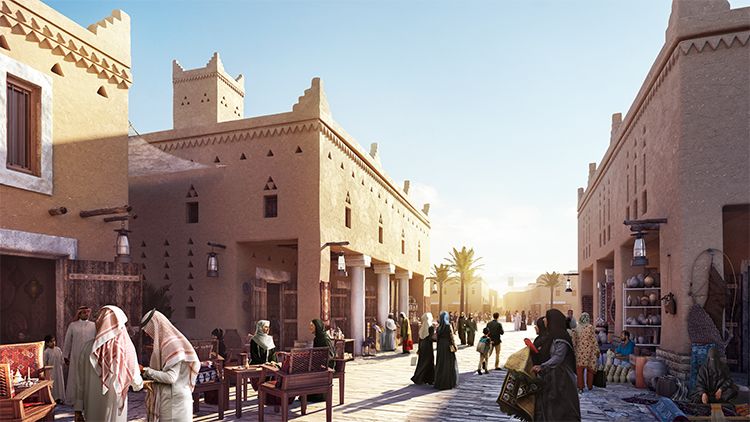
Diriyah is a low-rise development built with the same materials and architectural details found in At-Turaif.
But what makes Diriyah truly unique is that it will pay tribute to the cultural and social heritage of Saudi Arabia and shine a light on the story of the Kingdom, thanks to At-Turaif, the historical jewel at the heart of the development.
But what makes Diriyah truly unique is that it will pay tribute to the cultural and social heritage of Saudi Arabia and shine a light on the story of the Kingdom, thanks to At-Turaif, the historical jewel at the heart of the development.
“This is a chance for Saudi Arabia to show its traditions, its culture and its heritage to the world,” said Kensara.
“The master plan was fully inspired by At-Turaif, so the whole of Diriyah will offer a unique, traditional Najdi experience. The development will have the genuine look and feel of the old city.”
The most obvious homage to the historic district of At-Turaif in the wider Diriyah development is the striking use throughout of mud bricks and other key elements of the Najdi building style.
This, said Wilkinson, is in no way a pastiche but instead an entirely appropriate revival of a building style that was born of a certain time and place and is now seen as having timeless appeal and potential.
Dr. Badran Al-Honaihen, associate director of historical researches and studies at DGDA, on the importance of the Arabian horse in the story of Diriyah.
“Najdi architecture is unique,” he said. “What’s so fascinating about it is that it has adapted to its place, it is environmentally sound — and now it has become architecture for the modern world, in that the materials being used are almost zero-carbon.”
Before joining the project, Wilkinson spent 12 years as director of Edinburgh World Heritage, the organization that protects and promotes public understanding of the world-famous UNESCO World Heritage site in Scotland’s capital city.
As an outsider, he is struck by the great potential of Diriyah, both for Saudis and the way they see their heritage, and for the way the wider world views Saudi Arabia.
“For me, what’s fascinating about At-Turaif is that its foundational story is not known outside of Saudi Arabia. Most people outside of the Arabian peninsula just don’t know how Saudi Arabia came about, and there is an amazing story there to be told that will help to change people’s perceptions of Saudi Arabia fundamentally.”
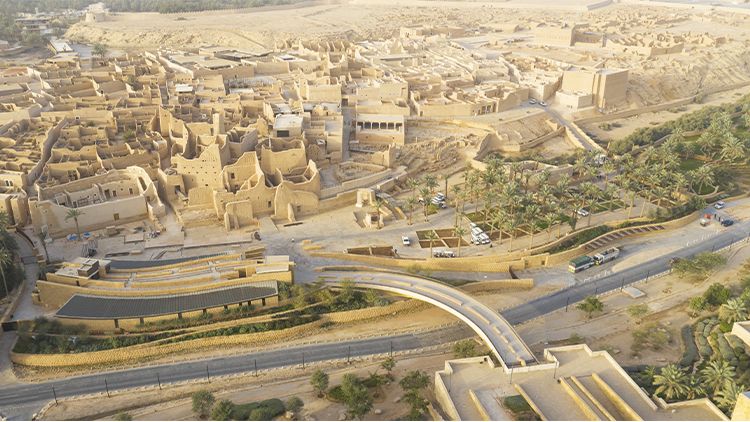
A wadi runs through it: for defensive reasons At-Turaif was built on a bend in the Wadi Hanifah.
A wadi runs through it: for defensive reasons At-Turaif was built on a bend in the Wadi Hanifah.
Visitors to Diriyah will learn the story of Saudi Arabia through multiple experiences, said Kensara: “Aside from amazing hospitality and hotel experiences, there will be a lot of cultural and heritage experiences for visitors to enjoy.”
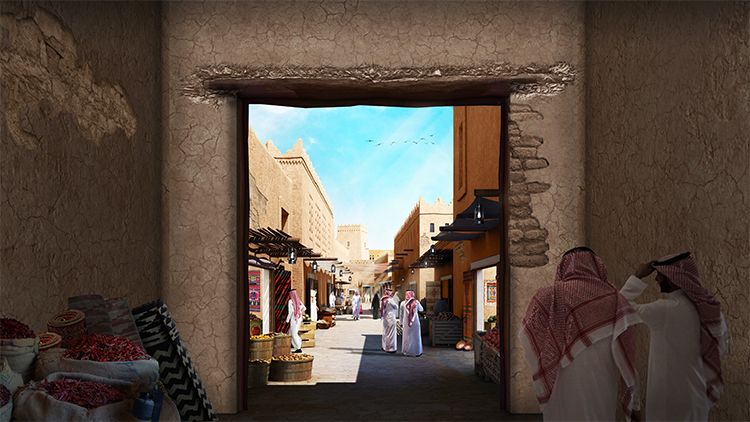
Diriyah Period Village, where storytellers will narate traditional tales, will recreate life 300 years ago.
At-Turaif will also offer the opportunity for people to meet and talk with young Saudi tour guides who are passionate about their heritage and history, such as Manal Al-Qahtani, who considers her job to be an honor.
“I am actually representing my country and its history,” she said. “I am an ambassador here in Diriyah.”
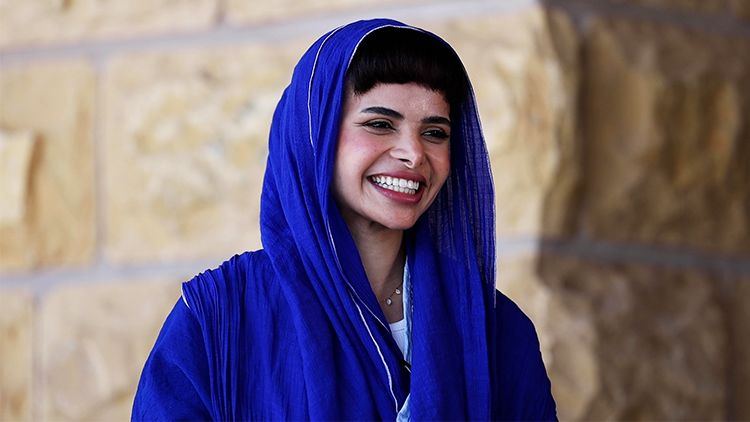
Manal Al-Qahtani, one of the Saudi tour guides keen to share their heritage with visitors to At-Turaif.
Manal Al-Qahtani, one of the Saudi tour guides keen to share their heritage with visitors to At-Turaif.
Museums will play a central part in the experience, with displays illustrating important historical and cultural developments such as the story of the birth of the Saudi state and the important role of horses in the unification of the Arabian peninsula. But the storytelling will not be limited to any single institution.
Experience life in the First Saudi State three centuries ago in the museums of At-Turaif.
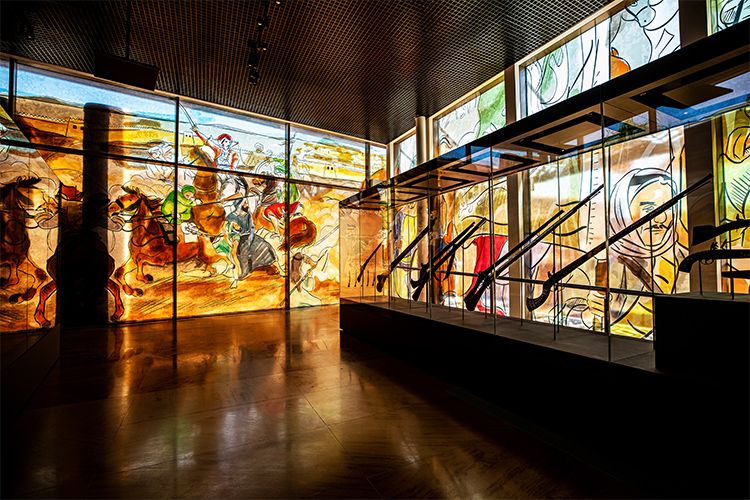
The military museum in At-Turaif is one of several focusing on life in the First Saudi State.
The military museum in At-Turaif is one of several focusing on life in the First Saudi State.
“One of the museums is the 100 Stories Museum,” said Kensara. “We have gathered 100 stories about Diriyah, and these stories will be brought to life, so it’s not a museum that is under one roof but a distributed experience across the site.”
In addition, there will be “a lot of amazing traditional cultural experiences,” Kensara said.
A music academy, for example, will offer short introductory courses on Arabic music, a planetarium will explore the contribution of the Arab world to science and, appropriately for a development that owes so much to the traditional builders of At-Turaif, another institution will focus on Najdi architecture and the art of building with mud.
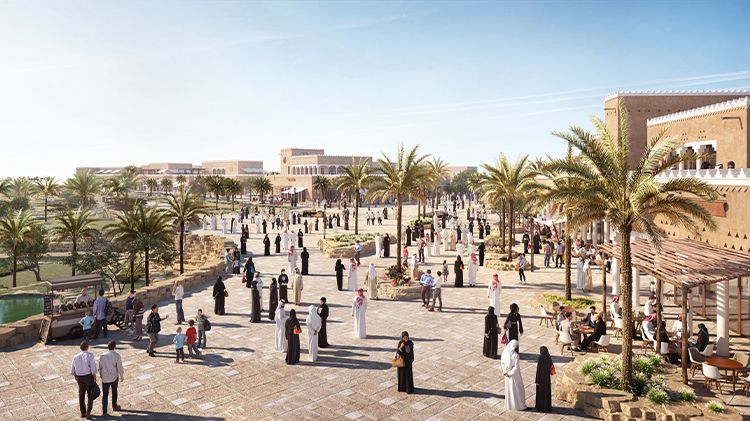
The dining district of Bujairi Terrace is the first part of Diriyah to be opened to the public.
Visitors will also be able to immerse themselves in subjects such as calligraphy, Najdi cooking and falconry and, by exploring the recreation of a village from the period, experience what life was like in Diriyah hundreds of years ago.
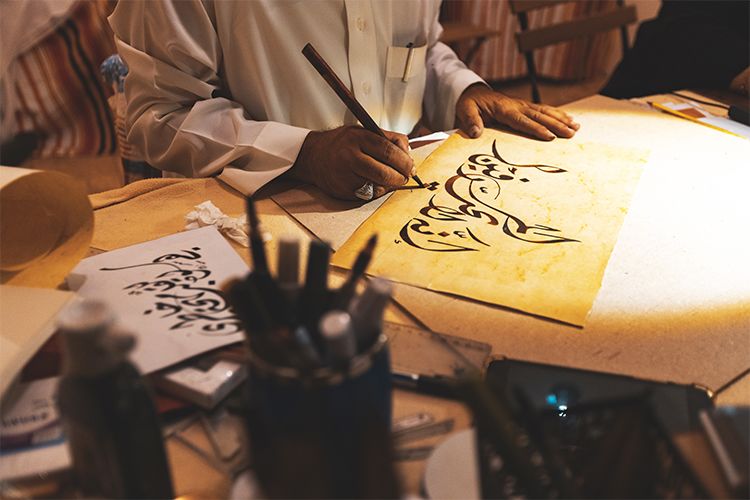
At Diriyah Gate visitors will have the chance to learn and practise ancient skills, such as calligraphy.
At Diriyah Gate visitors will have the chance to learn and practise ancient skills, such as calligraphy.
To the west of Diriyah will also be found 60 square kilometers of pure tranquility – Wadi Safar, home to vast stretches of pristine undulating golden sand dunes and the setting for a new level of luxury living, steeped in Saudi heritage. Conceived as a secluded retreat for the Kingdom’s most influential, Wadi Safar will bring together a globally peerless collection of luxury lifestyle and recreation experiences, set against a backdrop of natural beauty.
In short, said Kensara, Diriyah, a key component of Vision 2030, will help to tell the true story of Saudi Arabia as the country opens up to the world after decades behind closed doors.
“The main thing is for people to be able to experience the genuine Saudi culture, heritage and history, and to change the perception of Saudi Arabia,” he said. “And where can you experience all that better than in Diriyah, the birthplace of the Kingdom?”
Work on the massive amount of infrastructure necessary to support the Diriyah Gate project is already well advanced, but there is no single projected end date by which the full development will be complete and open.
“This project is not a theme park, where you cut the ribbon and say, ‘That’s it, it’s done,’” said Kensara. “It’s a rolling project where we will gradually offer different assets and experiences.”
These will begin to become available early next year with the reopening of Al-Bujairi, a dining district overlooking At-Turaif across the Wadi Hanifah. It is already familiar to residents of Riyadh but, with a number of new, top restaurants set to open, it is expected to build an international reputation.
A heritage hotel is also due to open soon, offering accommodation across a number of sites. The imposing King Salman Square is due to be completed by 2024, along with a number of attractions and facilities surrounding it, including a House of Al-Saud Museum, hotels, an art district and other cultural sites.
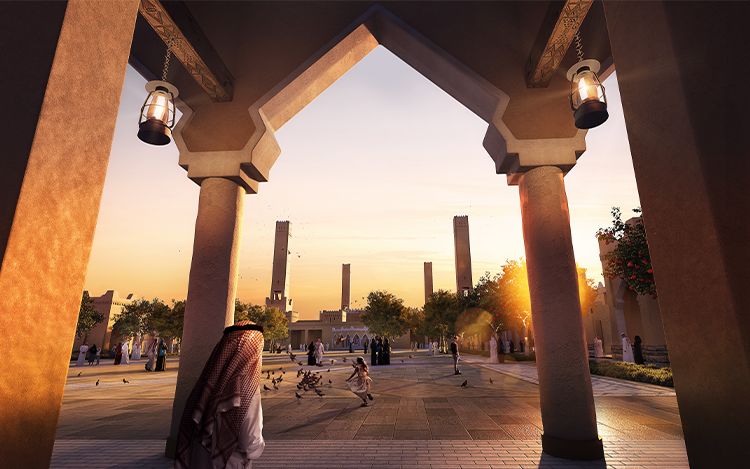
One of the most spectacular sights in Diriyah will be the King Salman Grand Mosque.
The planned art district “will be an amazing project,” said Kensara. “It will be a great platform for Saudi artists of all kinds, and a great opportunity for visitors to experience cultural activities, including art, music, acting, street performances or cooking.”
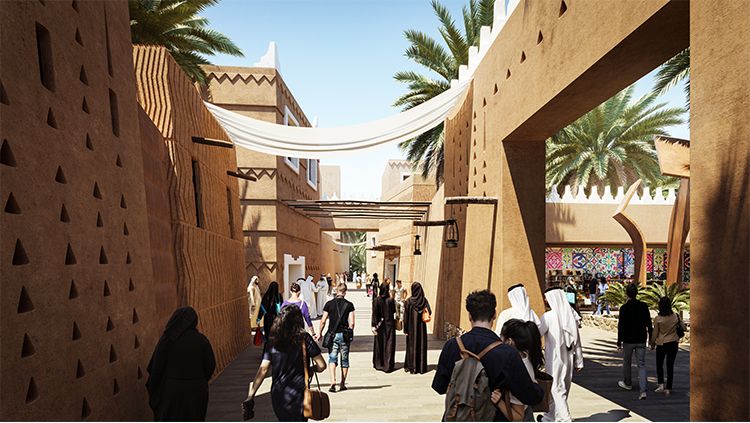
The meandering streets of the Art District will be home to creative businesses, art shows and cultural academies.
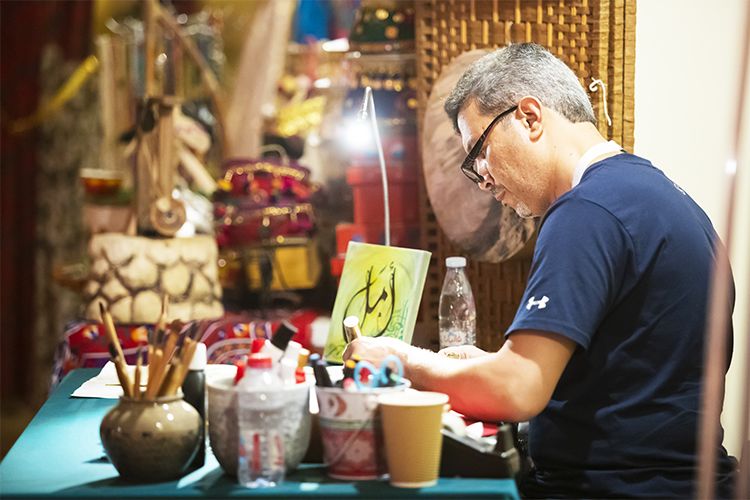
Communities of artists and entrepreneurs will flourish in dedicated districts at Diriyah Gate.
Communities of artists and entrepreneurs will flourish in dedicated districts at Diriyah Gate.
King Salman Square will be followed by the opening of Diriyah Square, a “lifestyle retail experience,” complete with restaurants, cafes and open spaces where visitors can relax and soak up the atmosphere.

In addition to hotels and offices, the Diriyah Square district will house luxury retail outlets.
Then the southern part of the site, Diriyah Gardens, will spring to life. In many ways, said Kensara, this will be the beating heart of the entire project.
“In order to create a destination like this with a genuine, living culture, you need people to actually live and work there, and Diriyah Gardens will be the place where they can do that,” he said.
Even here — alongside the apartments and other accommodation for a resident population of about 100,000 that will be built, like the rest of the project, in the traditional Najdi architectural style — there will be a number of museums, the period village and a falconry market.
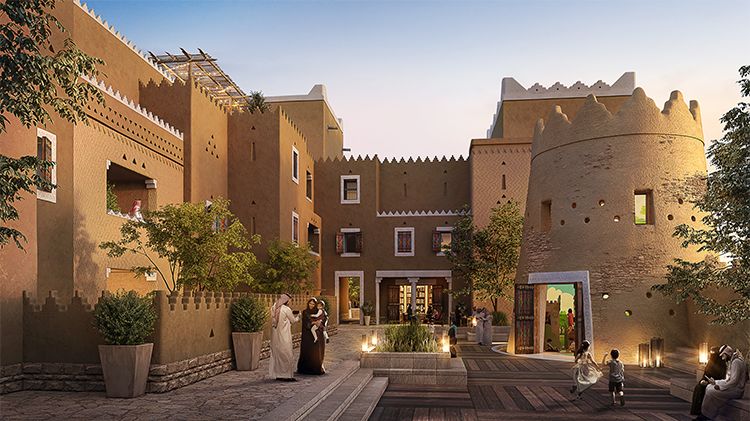
Traditionally styled apartments, townhouses and courtyard villas will offer the best in modern living.
A separate master plan is being developed for the eastern part of the site, the details of which have yet to be revealed.
The full initial project “will be rolled out over a number of years but by 2030 the whole site will be fully activated,” Kensara added.
For a project so closely associated with Saudi Vision 2030 — which aims, in the words of the crown prince at the launch of the national blueprint for the future, to “strengthen the Kingdom of Saudi Arabia’s position as a great nation in which we should all feel an immense pride” — this is a fitting target date.
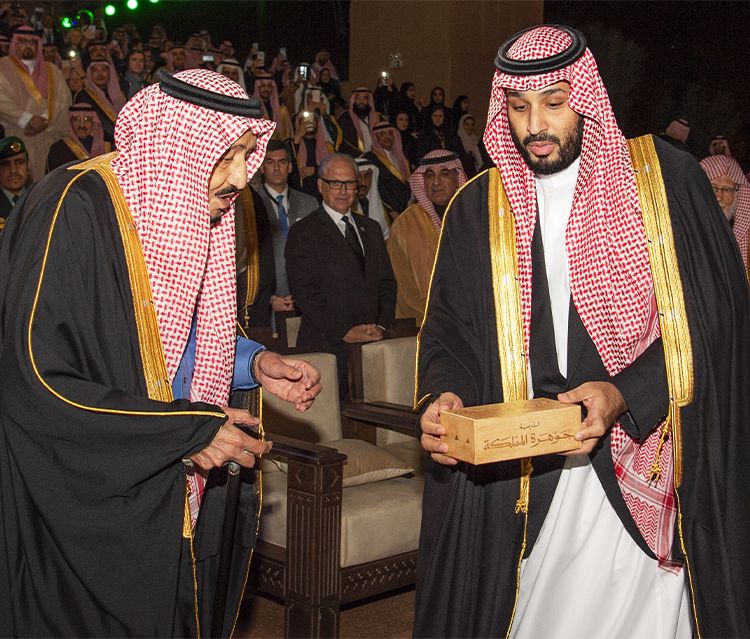
King Salman laid the foundation stone for Diriyah Gate in 2019. His son, Crown Prince Mohammed bin Salman, chairs the board steering the development.
King Salman laid the foundation stone for Diriyah Gate in 2019. His son, Crown Prince Mohammed bin Salman, chairs the board steering the development.
Kensara, former vice-deputy minister for shared services at the Ministry of Economy and Planning, freely admits that even though he is no stranger to major roles in big organizations, working on the Diriyah development is the biggest professional challenge of his career.
“Yes, it is a huge challenge,” he said, “but we are all very excited. It’s not only about the assignment, but because we feel responsible, even if only in a very small way, for shaping the future of Saudi Arabia.
“We have a great organization and a team of very talented people, and we cannot wait until we see the dream of Diriyah come true.”
This dream — rooted as it is so deeply in the fertile ground of At-Turaif, birthplace of the Kingdom — seems certain to flourish and blossom, and is just one among many seeds Saudi Arabia is planting as it throws open the gates to the once-secret gardens of its heritage to visitors from around the world.

Diriyah is a low-rise development built with the same materials and architectural details found in At-Turaif.
Diriyah is a low-rise development built with the same materials and architectural details found in At-Turaif.

Diriyah Period Village, where storytellers will narate traditional tales, will recreate life 300 years ago.
Diriyah Period Village, where storytellers will narate traditional tales, will recreate life 300 years ago.

The dining district of Bujairi Terrace is the first part of Diriyah to be opened to the public.
The dining district of Bujairi Terrace is the first part of Diriyah to be opened to the public.

One of the most spectacular sights in Diriyah will be the King Salman Grand Mosque.
One of the most spectacular sights in Diriyah will be the King Salman Grand Mosque.

The meandering streets of the Art District will be home to creative businesses, art shows and cultural academies.
The meandering streets of the Art District will be home to creative businesses, art shows and cultural academies.

In addition to hotels and offices, the Diriyah Square district will house luxury retail outlets.
In addition to hotels and offices, the Diriyah Square district will house luxury retail outlets.

Traditionally styled apartments, townhouses and courtyard villas will offer the best in modern living.
Traditionally styled apartments, townhouses and courtyard villas will offer the best in modern living.
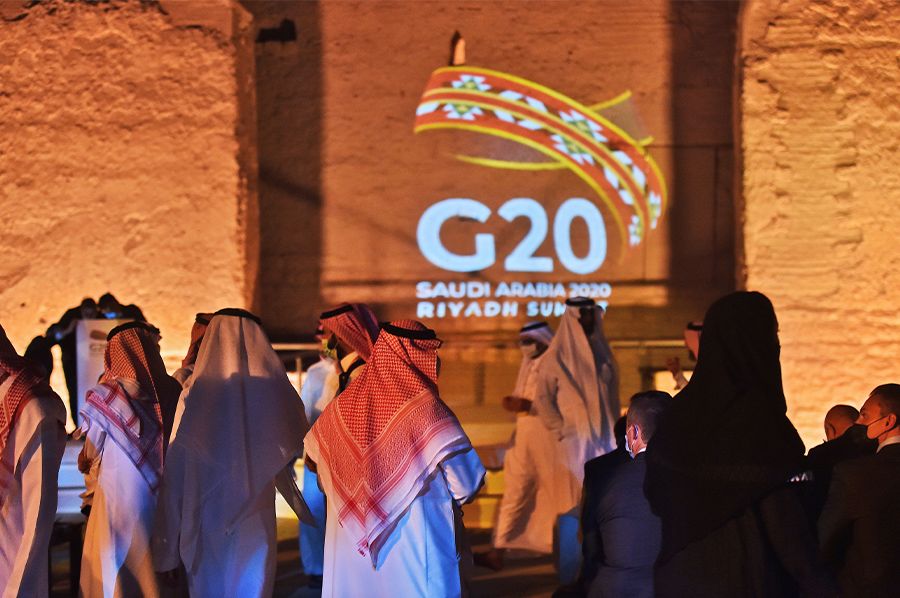
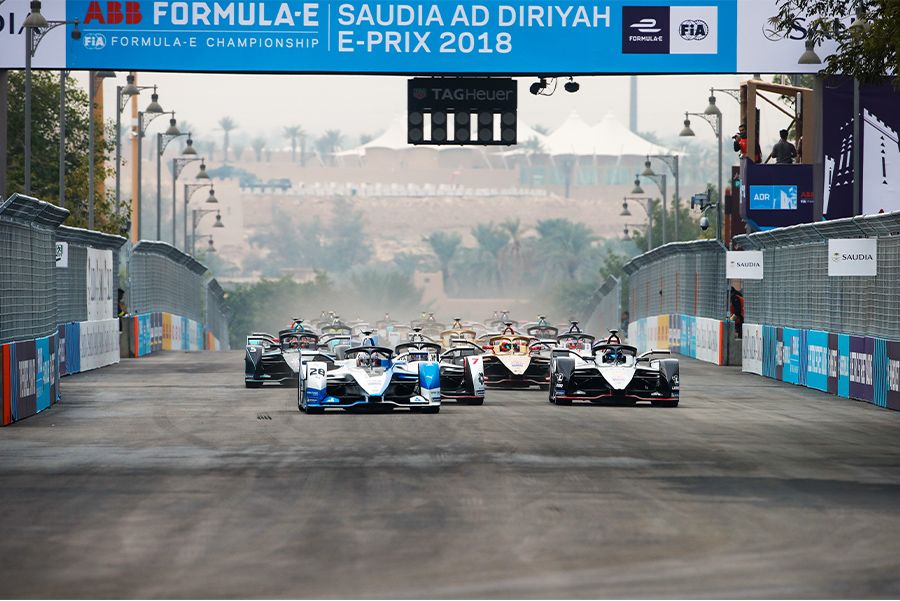
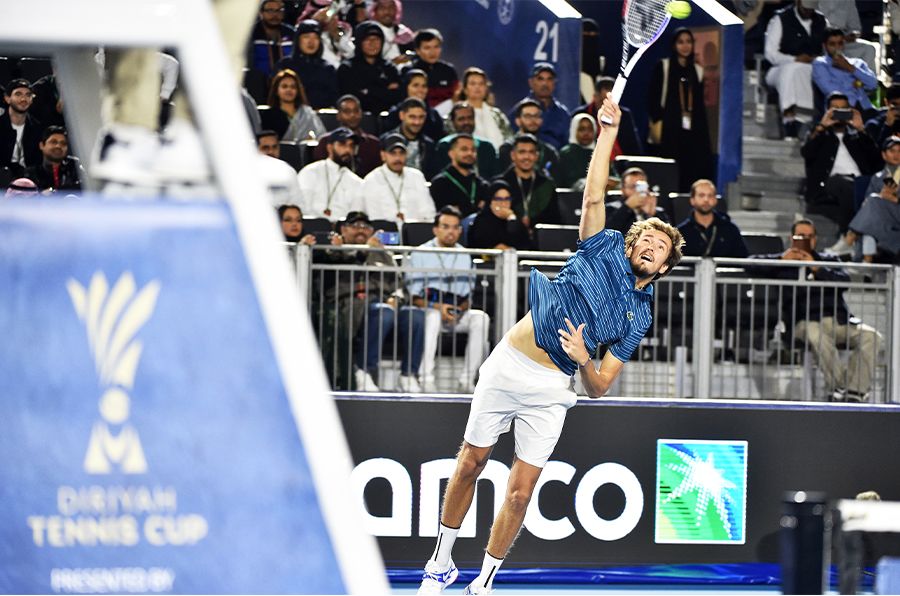
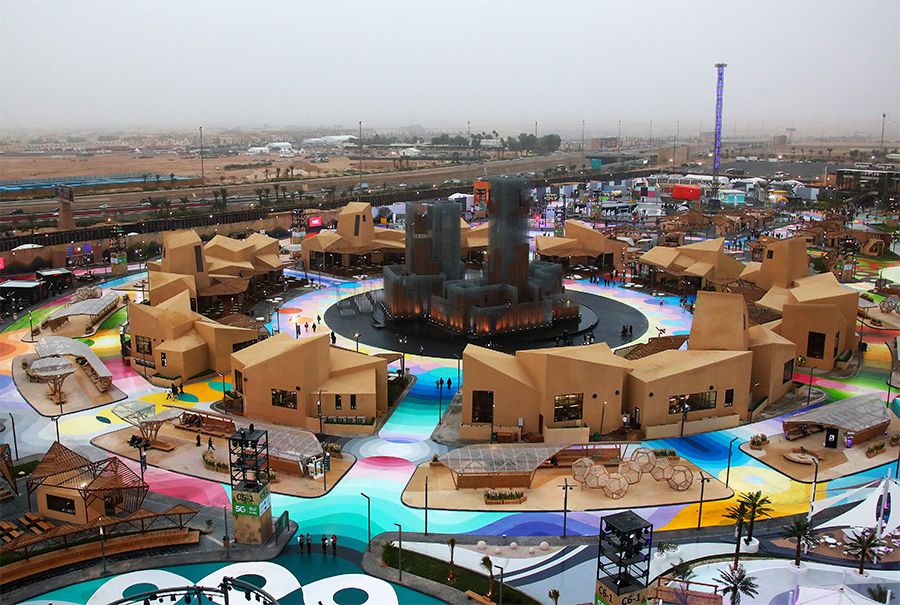
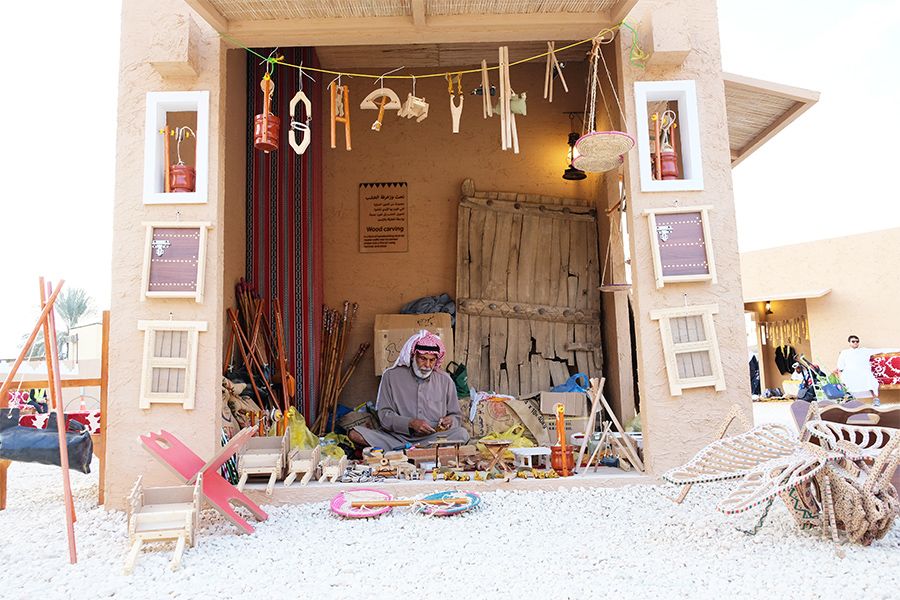
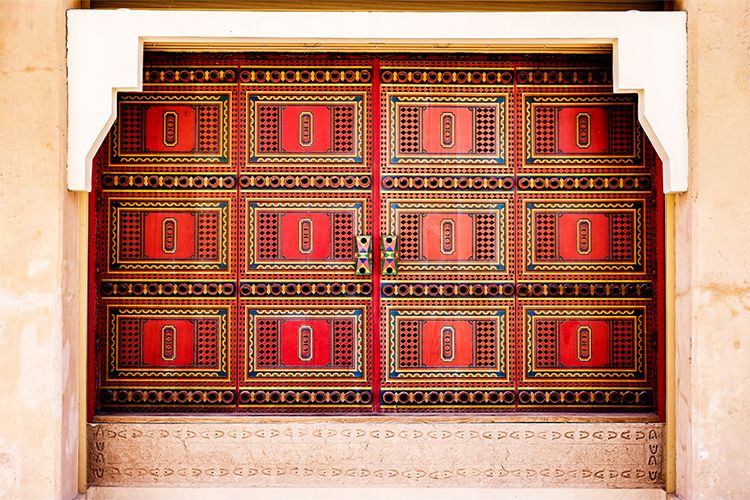

The G20 logo is projected onto the historic backdrop of the At-Tarif UNESCO site in Diriyah during the virtual Leaders' Summit, chaired in Riyadh by King Salman in November 2020 during Saudi Arabia's presidency of the Group of Twenty. (Getty Images)
The G20 logo is projected onto the historic backdrop of the At-Tarif UNESCO site in Diriyah during the virtual Leaders' Summit, chaired in Riyadh by King Salman in November 2020 during Saudi Arabia's presidency of the Group of Twenty. (Getty Images)

The inaugural Diriyah ePrix gets under way in December 2018 at the start of the 13-race 2018-2019 Formula E championship season. The race was won by Portuguese driver António Félix da Costa. (Getty Images)
The inaugural Diriyah ePrix gets under way in December 2018 at the start of the 13-race 2018-2019 Formula E championship season. The race was won by Portuguese driver António Félix da Costa. (Getty Images)

Daniil Medvedev of Russia in action during the final match of the Diriyah Tennis Cup. Held in December 2019, it was the first international tennis competition to be staged in Saudi Arabia. (AFP)
Daniil Medvedev of Russia in action during the final match of the Diriyah Tennis Cup. Held in December 2019, it was the first international tennis competition to be staged in Saudi Arabia. (AFP)

The Diriyah Oasis, a pop-up cultural and recreation area created in 2019 as the centerpiece of the first Diriyah Season of events showcasing the area's rich heritage. (Getty Images)
The Diriyah Oasis, a pop-up cultural and recreation area created in 2019 as the centerpiece of the first Diriyah Season of events showcasing the area's rich heritage. (Getty Images)

Traditional Saudi crafts were on show in the living museum of At-Turaif when Saudi Arabia staged the 2018 Diriyah ePrix, the first round of the 2018-2019 Formula E season for electrically powered racing cars. (Shutterstock)
Traditional Saudi crafts were on show in the living museum of At-Turaif when Saudi Arabia staged the 2018 Diriyah ePrix, the first round of the 2018-2019 Formula E season for electrically powered racing cars. (Shutterstock)

At-Turaif and the older parts of Diriyah are a treasure trove of architectural details from the time of the 18th-century First Saudi State, such as these traditionally decorated doors in Albujairi Square. (Shutterstock)
At-Turaif and the older parts of Diriyah are a treasure trove of architectural details from the time of the 18th-century First Saudi State, such as these traditionally decorated doors in Albujairi Square. (Shutterstock)
Credits
Writers: Jonathan Gornall, Lama Alhamawi
Research: Jonathan Gornall, Hanouf Albalawi, Diriyah Gate Development Authority
Project leader: Noor Nugali
Editor: Tarek Ali Ahmad
Creative director: Simon Khalil
Designers: Omar Nashashibi
Graphics: Douglas Okasaki
Video producer: Mohammed Qenan
Video editors: Abdulrahman Fahad Bin Shulhub, Nisar Illikkottil
Videographers: Faisal Aldakheel, Abdullah AlJabr
Picture researcher: Sheila Mayo
Copy editor: Liam Carney
French editor: Zeina Zbibo
Japanese editor: Diana Farah
Social media: Jad Bitar, Daniel Fountain
Producer: Arkan Aladnani
Editor-in-Chief: Faisal J. Abbas
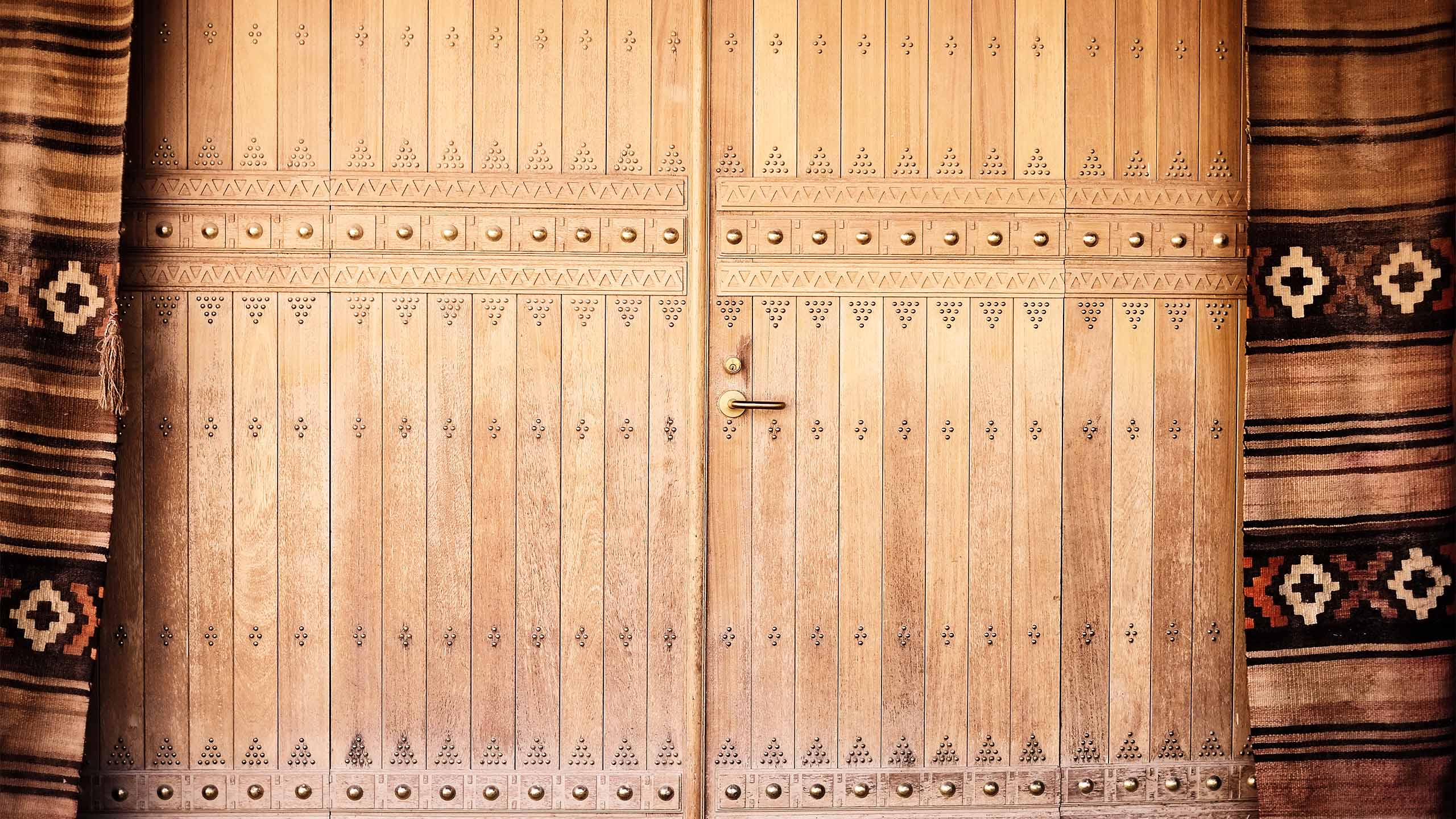
Saudi National Day coverage in Arab News
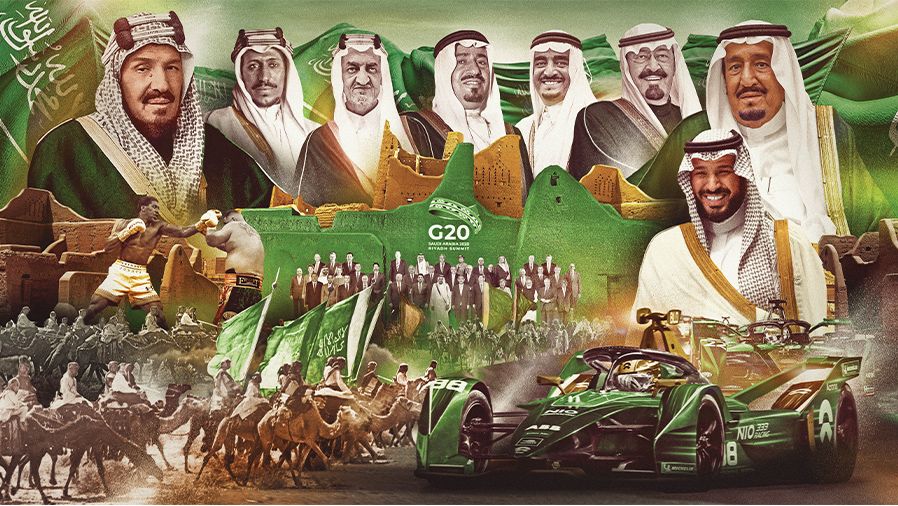
Articles
• The rich history of At-Turaif
• At-Turaif: A look into the jewel of the Kingdom's museums
• Diriyah through her eyes
• Diriyah: A fragile but 'enduring reminder of the frontiers of the possible'
• Masmak Fortress: An important historical symbol of Saudi unification
• Meet the Saudi tour guides bringing Diriyah’s past to life
• Princess Nourah: The woman who had ‘the brain of 40 men’
• Walking in the footsteps of the Saudi founding fathers at Salwa Palace
• The story of all the king’s men
• Looking after the environment in 18th century Najd
• Born in Brooklyn, but his heart is in Diriyah
Opinion
• French Ambassador praises links with Saudi Arabia on National Day - Ludovic Pouille
• Diriyah is a beacon of the Saudi transformation - Iwai Fumio
• Remarks by the Chinese ambassador to Saudi Arabia, on the occasion of Saudi National Day - Chen Weiqing
• Saud the Great and Mohammed the future - Dr Badran AlHonaihen
